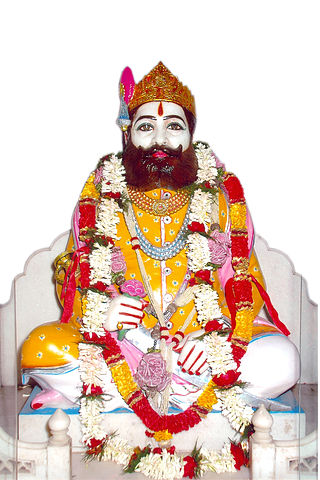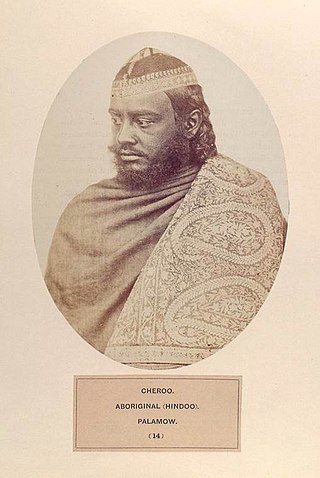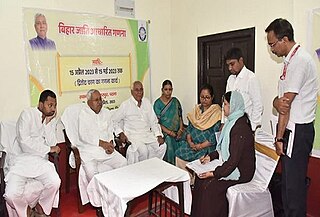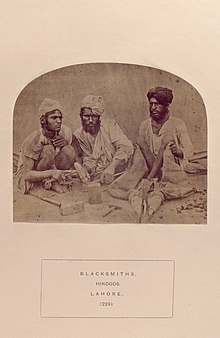The Other Backward Class (OBC) is a collective term used by the Government of India to classify castes that are educationally or socially backward. It is one of several official classifications of the population of India, along with general castes, Scheduled Castes and Scheduled Tribes (SCs and STs). The OBCs were found to comprise 52% of the country's population by the Mandal Commission report of 1980 and were determined to be 41% in 2006 when the National Sample Survey Organisation took place. There is substantial debate over the exact number of OBCs in India; it is generally estimated to be sizable, but many believe that it is higher than the figures quoted by either the Mandal Commission or the National Sample Survey.
Bihari is a demonym given to the inhabitants of the Indian state of Bihar. Bihari people can be separated into three main Indo-Aryan ethnolinguistic groups, Bhojpuris, Maithils and Magadhis. They are also further divided into a variety of hereditary caste groups. In Bihar today, the Bihari identity is seen as secondary to caste/clan, linguistic and religious identity but nonetheless is a subset of the larger Indian identity. Biharis can be found throughout India, and in the neighbouring countries of Nepal, Pakistan and Bangladesh. During the Partition of India in 1947, many Bihari Muslims migrated to East Bengal. Bihari people are also well represented in the Muhajir people of Pakistan because of Partition.
Reservation is a system of affirmative action in India created during the British rule. It provides historically disadvantaged groups representation in education, employment, government schemes, scholarships and politics. Based on provisions in the Indian Constitution, it allows the Union Government and the States and Territories of India to set reserved quotas or seats, at particular percentage in Education Admissions, Employments, Political Bodies, Promotions, etc., for "socially and educationally backward citizens."

Teli is a caste traditionally occupied in the oil pressing and trade in India, Nepal and Pakistan. Members may be either Hindu or Muslim; Muslim Teli are called Roshandaar or Teli Malik.

Agrahari, Agraharee or Agarhari is an Indian Vaishya community, They are the descendants of legendary king Agrasena. Predominantly, they are found in the Indian state of Uttar Pradesh, Madhya Pradesh, Jharkhand, Chhattisgarh and Terai region of Nepal.
Kushwaha is a community of the Indo-Gangetic Plain that has traditionally been involved in agriculture, including beekeeping. The term has been used to represent different sub-castes of the Kachhis, Kachhvahas, Koeris and Muraos. Under the Indian governments system of positive discrimination, the Kushwahas are classified as a "Backward" or Other backward class. The Kushwaha had worshipped Shiva and Shakta, but beginning in the 20th century, they claim descent from the Suryavansh (Solar) dynasty via Kusha, one of the twin sons of Rama and Sita. At present, it is a broad community formed by coming together of several caste groups with similar occupational backgrounds and socio-economic status, who, over the time, started inter-marrying among themselves and created all India caste network for caste solidarity. The communities which merged into this caste cluster includes Kachhi, Kachhwaha, Kushwaha, Mali, Marrar, Saini, Sonkar, Murai, Shakya, Maurya, Koeri and Panara.
At the 2011 Census, Bihar was the third most populous state of India with total population of 104,099,452, nearly 89% of it is rural. It was also India's most densely populated state, with 1,106 persons per square kilometre. The sex ratio was 918 females per 1000 males. Almost 58% of Bihar's population was below 25 years age, which is the highest in India. At 11.3%, Bihar has the second-lowest urbanisation rate in India after Himachal Pradesh.
The demographics of Uttar Pradesh is a complex topic, which is undergoing dynamic change. Uttar Pradesh is India's most populous state, and the largest subdivision in the world. It has a population of about 199,812,341 as per the 2011 census. If it were a separate country, Uttar Pradesh would be the world's fifth most populous nation, next only to China, India, the United States of America and Indonesia. Uttar Pradesh has a population more than that of Pakistan. There is an average population density of 828 persons per km² i.e. 2,146 per sq mi. The capital of Uttar Pradesh is Lucknow, and Prayagraj serves as the state’s judicial capital. Hindus and Muslims both consider the state as a holy place.
The Khatik is a caste found in the Indian subcontinent, mainly modern-day India, Pakistan and Nepal. Khatik are located mainly in New Delhi, Haryana, Rajasthan, Madhya Pradesh, Uttar Pradesh, Maharashtra, Telangana, Andhra Pradesh and Himachal Pradesh.
Yadav, Jadam, or Jadav refers to a grouping of traditionally non-elite, peasant-pastoral communities or castes in India that since the 19th and 20th centuries have claimed descent from the mythological king Yadu as a part of a movement of social and political resurgence. The term Yadav now covers many traditional peasant-pastoral castes such as Ahirs of the Hindi belt and the Gavli of Maharashtra.
The Kewat, also spelled Kevat, is a Hindu caste, found in the states of Rajasthan, Madhya Pradesh, Chhattisgarh, Odisha, Bihar and Uttar Pradesh in India. They are the traditional boatmen of northern India, and also in neighbouring country Nepal.

Tailoring is a profession which is done by the people of different religions and communities of the world for their livelihood or as business in modern times. Talking about the old times, the tailoring business can be seen among the communities. In the Indian tradition, it was customary to wrap it over the body rather than wearing it. Nowadays wrap clothes tradition is limited. Most of the people prefer to wear stitched clothes.
The Bind are a caste found in Uttar Pradesh, Bihar, Madhya Pradesh, Assam, West Bengal, Chhattisgarh and Tripura. Bind are under the OBC category of the central list. Bind is one of the Nishad communities. In Uttar Pradesh, they are known by the Kewat sub-caste. In Bihar Bind comes under OBC.

The Chero is a caste found in the states of Bihar, Jharkhand and Uttar Pradesh in India.

Kumhar or Kumbhar is a caste or community in India, Nepal, Bangladesh and Pakistan. 'Kumhar' have historically been associated with the art of pottery.
Kandu or Kanu (Halwai) is a social group or caste that belongs to the Vaishya varna of the Hindu religion. The community is also referred to as Madheshia Vaishya. They are also identified with the term Bania of the Tirhut and Madhesi region, representing a community that has been historically associated with sweet-making, smaller trading activities, business, shop-keeping, grain -parching etc. in the eastern parts of India.
Economically Weaker Section (EWS) in India is a subcategory of people having an annual family income less than ₹8 lakh (US$10,000) and who do not belong to any category such as SC/ST/OBC across India, nor to MBC in Tamil Nadu. A candidate who does not fall under SC/ST/OBC and fulfils the EWS economic criteria are to be part of the EWS category.
Bari or Baridar are a Hindu caste mostly living in Northern India.

The 2022 Bihar Caste Based Survey was notified by the Government of Bihar on 6 June 2022 by gazette notification after a Supreme Court ruling. The survey was conducted in two phases, house listing and caste and economic enumeration. The data collection for the survey began on 7 January 2023 and the data was released on 2 October 2023. The responsibility to conduct the survey was given to the General Administration Department (GAD) of the Government of Bihar. The government planned to collect the data digitally by mobile application named Bijaga- Bihar Jaati Adharit Ganana. BELTRON, a Government of Bihar agency provided IT support, hired the services of a Maharashtra-based private firm Trigyn Technologies to develop the mobile app.







